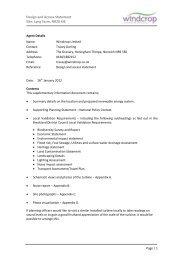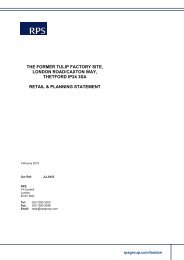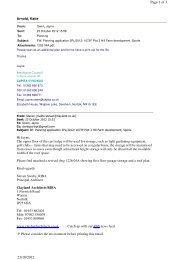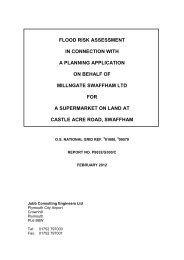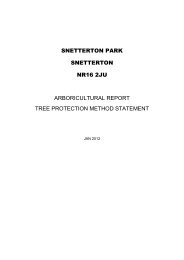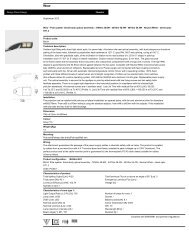HERITAGE STATEMENT ST PETERS CHURCH THETFORD For THETFORD COUNCIL
Heritage%20Statement%20February%202013.pdf
Heritage%20Statement%20February%202013.pdf
Create successful ePaper yourself
Turn your PDF publications into a flip-book with our unique Google optimized e-Paper software.
Of the early medieval church of St Peter’s we know very little, but it does stand at an important<br />
and very early east/west – north/south crossing and adjacent to what was the medieval Manor<br />
house, now King’s House. According to the 18 th Century historian, Francis Blomefield, the 2 nd<br />
Earl Warren, Thetford’s feudal Lord, gave St Peter’s Church to the Cluniac Priory at Lewes, with<br />
whom it continued until the dissolution. It is quite possible that St Peter’s Church was originally<br />
built by the Manorial Lord as a private chapel. It then became a parish church at a later date. By<br />
this time, land on the north side was occupied. Perhaps this goes some way to explain why it has<br />
such a very small churchyard.<br />
In 1291 a list of churches (numbering about 8,500 in England), was complied for taxation. It is<br />
known as the “Taxation of Pope Nicholas VI”. Five of Thetford’s churches are listed: St Mary, St<br />
Nicholas, St Cuthbert, St Giles and St Edmund. Unfortunately St Peter’s is not amongst them.<br />
Was it then either too small or poor to be taxed at this time?<br />
However, St Peter’s Church, along with eleven other local churches, does appear the following<br />
century when in 1368 an inventory of church goods in the Archdeaconry of Norwich was made.<br />
It lists the various sacred vessels, objects and garments that were used at the time.<br />
The first description of St Peter’s Church, is that given in the early years of the 18 th Century,<br />
when the historian the Reverend Francis Blomefield recorded something of the church for his<br />
history of Thetford published in 1739. He wrote, “The Head Church of the three” .. “the present<br />
building is of Freestone and Black Flint, and by the appearance of it, don’t seem to exceed the<br />
time of Edward III, (1327-77) it hath six bells in a square tower, so cracked it seems very weak;<br />
the Nave, North Isles, and two chapels are leaded, but the chancel is tiled. The plan of the church<br />
– chancel, nave with north aisle and western tower is Early English (13 th Century).<br />
Blomefield’s contemporary, the local historian, Thomas Martin, also described St Peter’s church<br />
for his history of Thetford published posthumously in 1779. “It is built of free-stone and flint,<br />
whence it has the vulgar name of “Black Church”. It consists of a chancel, nave, and two aisles,<br />
the chancel tiled, the rest leaded. Its square west tower built on arches which open on the north<br />
and south sides is much cracked, and contains six bells.<br />
<strong>For</strong>tunately, not only do we have this description from Martin but perhaps even more<br />
interestingly, a drawing he made of the church, somewhere about the middle of the 18 th Century.




